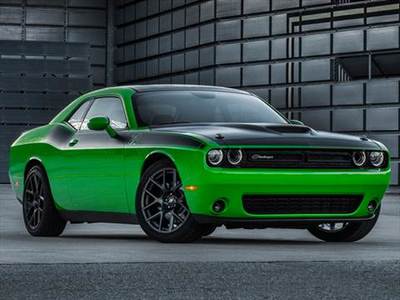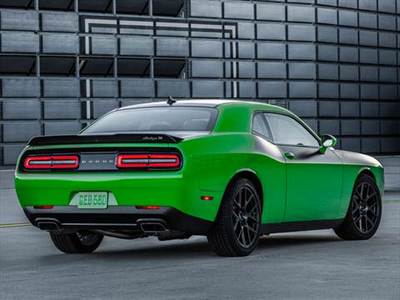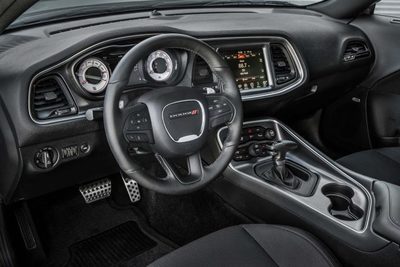Car Review: 2017 DODGE CHALLENGER T/A 392 Review By Steve Purdy
2017 DODGE CHALLENGER T/A 392
Review by Steve Purdy
The Auto Channel
Michigan Bureau
The Dodge marketing folks call the Challenger a “1970s era throwback,” and that certainly is a major part of its charm and personality. But I can definitively say, as one who drove the muscle cars of the 70s, it is much more than that. Yes, the retro styling, raw power, great gobs of cool noise and pure machismo reflect that history, but modern engineering and technology has made it so much more all around competent, durable and easy to live with that we now really have the best of both worlds.
This rear-wheel drive Challenger is a 2+2 coupe offered with three different engines - a 300-hp V6, 5.7-liter Hemi V8 making about 375 horsepower and this 6.4-liter Hemi. Challenger is the Dodge brand’s version of a modern pony car/muscle car competing head-to-head with Mustang and Camaro. Only these three fit into this unique niche.
Styling and design reflect the earlier-referenced “throwback,” or retro theme, with simple, unpretentious details inside and out. Challenger, to me, looks and feels to be the largest of the modern pony cars and it sits on essentially the same Mercedes-designed platform as the Charger and Chrysler 300. If you look at the new Challenger next to the iconic original from the early 1970s you’ll find it is stylistically true to its heritage though considerably larger. Our test car sports huge 20”X9.5” forged, painted aluminum wheels with a dull-black color that mitigates the dust coming from the high performance brake pads. Illuminated rings around the headlights (the outboard two are lights with the inboard two being air intakes), large areas of flat-black, or “satin black” surfacing that compliments the car’s “Destroyer Grey” paint, bold graphics, superfluous-but-cool hood pins and an uncovered fuel filler door confirm the special nature of this car.
Inside is where we get the feeling of the Challenger’s size. Looking out over the big, domed Grabber hood is our first clue to its special personality. The dash is essentially one large molding with instrument cluster, multi-purpose screen and HVAC controls nested therein. Most modern cars sport complex dash designs with dozens of elements, materials and shapes. Not so the Challenger. It is simple, retro and functional making no pretense of bowing to modernity. Bravo! I say.
Believe it or not, we had a rear seat passenger this week. Fortunately, he is small and reasonably agile for an old guy, but it was still a struggle to squeeze him in through the dismally tight space between the seatback and the B-pillar. That rear seat is not good for anyone but small children and dogs. It’s even hard to put cargo back there because it is so hard to access the space. But, that’s not what this car is all about. The front cabin – driver and passenger space – is comfortable, generous and stimulating with plenty of room even for this oversized reviewer.
Part of the charm of the cabin is the wonderful noise coming from the car’s active exhaust - standard on all 2017 Challenger and Charger Hemis. At start up and idle it bursts to life with a raucous bark and settles into a throaty burble. As it rubles away from idle the grumble grows nicely until you put your foot in it. Then it roars like a big bore racer. Baffles inside the exhaust system open wider with throttle input. It is never quiet enough to get out of the neighborhood unnoticed. Cruising down the highway, though, it is quiet enough inside that you can still easily converse with your passenger, at least until you inevitably punch it again.
That grin-inducing noise originates from the big 6.4-liter Hemi V8 making 485 horsepower and about 470 pound-feet of torque. Essentially a truck engine, it has been revised and updated with variable cam, increased compression ratio, dual-runner intake, cylinder deactivation and a variety of other high-tech enhancements to increase power and durability while improving fuel mileage. I managed just over 23 mpg with my foot in it a good share of the time through my two tanks of fuel in a week of daily use. My experience was about half highway and the rest suburban and rural environments. The EPA estimates 15 mpg in the city, 25 on the highway and 18 combined. Cylinder deactivation contributes to that mileage number. It doesn’t even require premium fuel.
Both Challenger and Charger Hemi-powered versions come standard with a six-speed manual transmission. Most, though, are delivered with the eight-speed automatic we had in our test car – a $1,500 option. The base price on our Challenger T/A 392 shows $37,999, but we have a plethora of options that bring it up to $53,995. You’ll get a thrilling level of performance at the base price but not a lot else. Our options include: a ton of special trim and appearance stuff, the 20-inch wheels shod with Perilli P Zero sticky tires, the Technology Package with navigation, Leather Package, Harmon Kardon Premium Sound system, and probably everything else on the option list. This one is loaded.
So, what was the driving experience like, you ask?
Well, in a word I would call it thrilling.
As I alluded earlier in this narrative it feels big at first. And, it is big compared to most high-performance cars. But it does not feel cumbersome. Stiff suspension allows us to push it as hard as we like while continuing to feel planted, though you’ll not want to spend any more time than necessary on rough, potholed roads. Not that it will become unstable. Rather, it will beat you up. Braking is accomplished though Brembo high-performance units with six-piston calipers on the front. All Challenger T/As come with the Track Pak™ that includes slightly lowered suspension, Bilstein shocks, high-performance brake linings (that produce a lot of dust to mess up your wheels), three-mode stability control and sticky tires.
I’ve driven the Challenger H ellcat with, I think, identical suspension tuning on the racetrack and it is right at home there. Steering is quick with enough feedback to keep us entertained. And, those sticky Pirelli tires add to the amazing feel of stability, though you’ll not get many miles on them before they need replacement.
But the best part of the driving experience is all that power under your right foot. Even with light throttle input you can feel the grunt just begging to be let loose. At half throttle you’ll be grinning ear to ear. And, at full throttle . . . well, let’s just call it adrenalin on demand.
The Dodge limited warranty covers the whole car for 3 years or 36,000 miles and the incomparable powertrain for 5 years or 60,000 miles.
The muscle cars of the 1970s were certainly powerful brutes but unless they were set up for racing you wouldn’t dare try to push them around a road course. This modern muscle car can go right from the showroom to the racetrack.
By the way, the Challenger T/A 392 comes with a 180 mph speedometer, but I did not peg it. Put me on a high-speed track like our nearby Michigan International Speedway, though, and I’ll give it a go.
© Steve Purdy, Shunpiker Productions, All Rights Reserved
MORE DODGE VEHICLE DATA AND RESEARCH TOOLS





